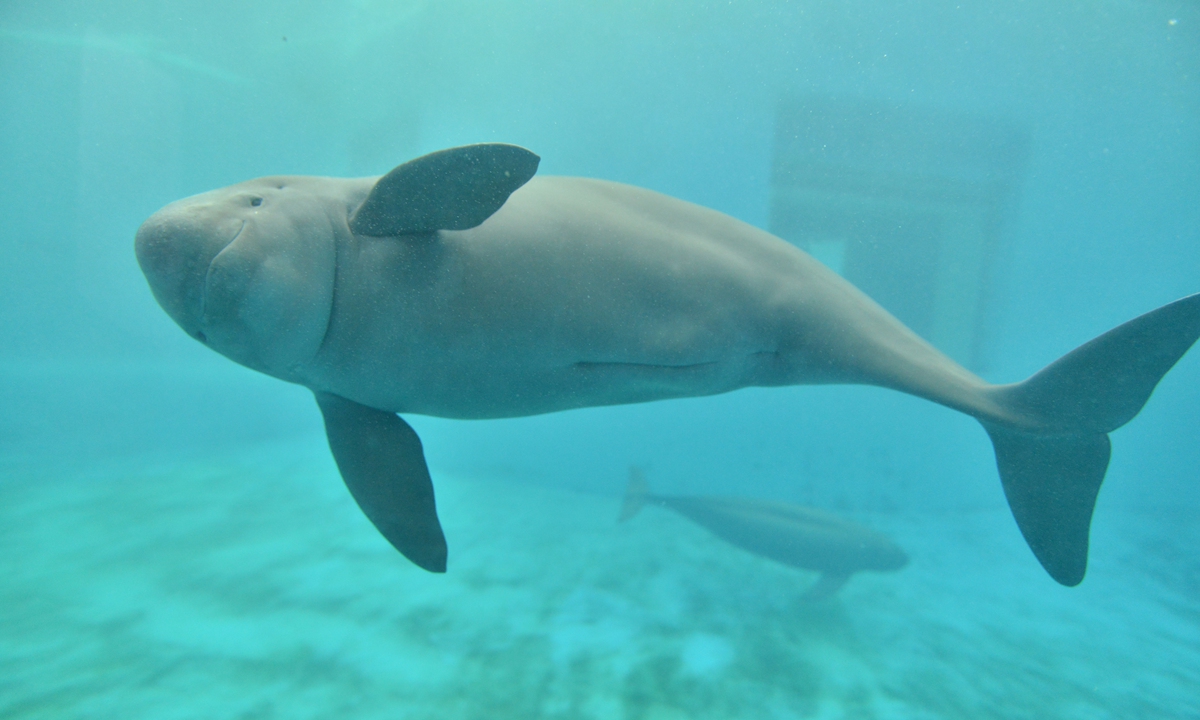China’s advanced technologies support protection of endangered Yangtze finless porpoise

Yangtze finless porpoise. (Photo: Courtesy of the Institute of Hydrobiology, Chinese Academy of Sciences)
In a light drizzle, two playful Yangtze finless porpoises darted through the waters of Xin-Luo Baiji National Nature Reserve, occasionally surfacing as they hunted for fish. The Global Times observed their rewilding process in Wuhan, Central China's Hubei Province.
The Yangtze finless porpoise, famous for its playful smile and intelligence comparable to that of a 3-4-year-old child, is a small mammal native to China's Yangtze River. As a top-level protected species, it serves as a unique symbol of the river and a key indicator of its health.
Balancing the economic development of the Yangtze River with the survival of endangered species remains a critical priority. "Overfishing has led to many porpoises getting trapped in nets, while the noise from boats disrupts their echolocation, making it difficult for them to find food," Wang Ding, president of the Wuhan Baiji Conservation Foundation (WBCF) and research professor at the Institute of Hydrobiology (HIB) at the Chinese Academy of Sciences, told the Global Times on Friday.
Human activities have caused a sharp decline in the Yangtze finless porpoise population, leaving only around 1,012 individuals by July 2018. To combat this decline, conservation institutes have relocated some porpoises to safer areas for ex-situ conservation. In these controlled environments, they are trained to improve foraging skills and monitored for reproduction, before being reintroduced into the more complex waters of the Yangtze River.
Resulting from a 10-year fishing ban in the Yangtze waters since 2021 and scientific measures, the population had increased to 1,249 in 2022, a 23.4 percent rise over five years, with an average annual growth rate of 4.3 percent, marking initial success in conservation efforts, according to official data.
High-tech protection
Advanced technologies play a crucial role in tracking the population and living conditions of the Yangtze finless porpoise. "Our monitoring system has been in place for 20 years, but intelligent detection technology has only been introduced in recent years," Wang told the Global Times on Friday.
Wang noted the current intelligent monitoring system allows 24/7 automated surveillance, complementing traditional methods by enabling long-term monitoring of animal activity in specific areas. By accurately identifying porpoise vocal signals, the system analyzes their frequency and direction, providing essential data for research and conservation. Additionally, it can automatically deploy drones to monitor the animals when they surface, enhancing real-time observation and protection efforts, according to Wang.
"The intelligent system first put in place in 2022 allows for more accurate monitoring of the porpoise population. We aim to make it smarter and expand its coverage," Hu Hongxia, head of the finance department at Tian'ezhou Nature Reserve, told the Global Times on Friday.
High-tech equipment has also been developed to help the rewilding process of porpoises. "We fitted the rewilded porpoises with small, lightweight, detachable vests. Using satellite tracking and radio signals, we monitored their adaptation and integration after release. Within days, they showed no signs of discomfort and quickly joined the group," said Mei Zhigang, deputy secretary-general of the WBCF and associate researcher at HIB.
Mei noted that because the vests can easily detach, they have implanted tiny, rice-sized microchips in the rewilded porpoises for long-term tracking. So far, four porpoises have been successfully released, marking a global first in rewilding an endangered aquatic mammal and showcasing China's unique contribution to biodiversity conservation.
Digital support
In addition to high-tech monitoring, raising public awareness about porpoise conservation through digital outreach is equally important. The Wuhan government, in collaboration with other agencies and businesses, launched a digital Yangtze porpoise IP, created the "iPorpoise" WeChat mini-program, and produced porpoise-themed merchandise.
The live stream of the Yangtze finless porpoise "Xiao Jiujiu" giving birth in 2022, co-hosted by the WBCF and Xinhua, garnered over 220 million views, while the global naming campaign for "Hanbao" attracted 100 million participants. These events highlight the growing public interest in Yangtze porpoise conservation, showcasing how digital platforms can effectively engage and inspire support for endangered species.
China's tech giant, Lenovo, officially announced on Thursday that it has adopted a female Yangtze finless porpoise undergoing rewilding training, named No. 1575, making it the first company to adopt a porpoise.
Lenovo unveiled a digital avatar and merchandise inspired by the Yangtze finless porpoise "No. 1575" and, in collaboration with relevant government agencies and businesses, developed a soon-to-be-released digital "Porpoise Tracking Map".
Liu Wei, director of Smart Devices and Solutions at Lenovo Research, said the initiative aims to raise public awareness of endangered species, promoting conservation efforts and shifting the focus from ex-situ conservation to the broader goal of restoring wild populations.
Lenovo will apply AI technology to monitor and study the Yangtze finless porpoise, offering data to support rewilding and habitat restoration efforts. Their smart devices are also helping teams work more efficiently, Liu said.
Balancing economic development, technological progress, and environmental harmony has been a long-standing challenge for humanity. "We will continue to prioritize a people-centered approach, exploring advanced technologies that promote harmony with nature. As a tech company, we are committed to contributing to biodiversity conservation and improving the well-being of society," Liu said.
In early 2024, the Ministry of Ecology and Environment released the China Biodiversity Conservation Strategy and Action Plan (2023-2030), making biodiversity protection a national priority. In August, four ministries issued the 2023 Report on Aquatic Resources and Habitats in the Yangtze River Basin. Ministry of Agriculture and Rural Affairs emphasized the urgency of protecting endangered species in the Yangtze River.
The greater collaboration between the government, research institutions, and businesses is essential to safeguarding these vulnerable species like the Yangtze finless porpoises.
Photos
Related Stories
- World’s first 100-kilometer hydrogen-powered multi-rotor drone successfully debuts
- Tailored protection to help nature's old-timers live on for generations to come
- China’s new transport UAV with 1,800 km range sets efficiency benchmark with 15-minute cargo turnaround
- Exhibition kicks off in Beijing to commemorate 60 years of international scientific cooperation
- Smart tech cultivates fertile, high-yield lands across China
- Baby elephant party
Copyright © 2024 People's Daily Online. All Rights Reserved.









